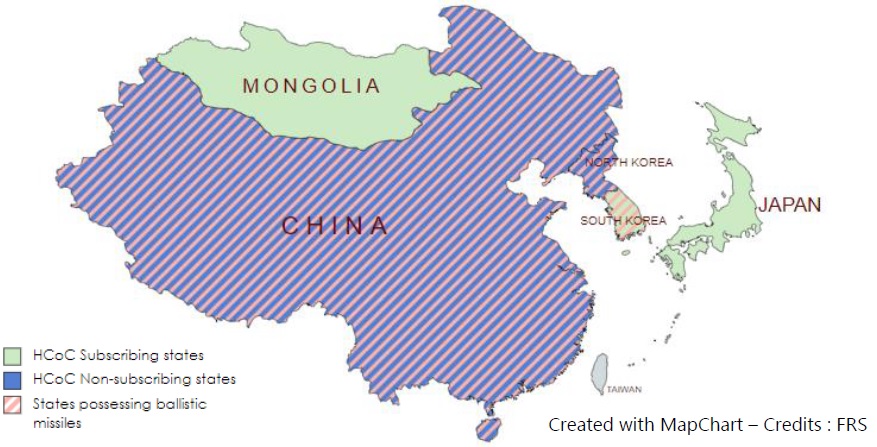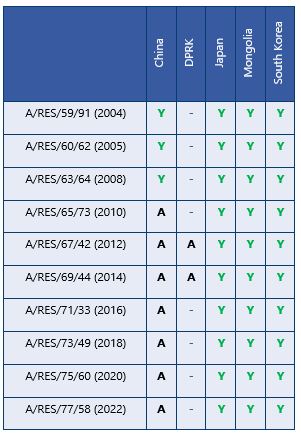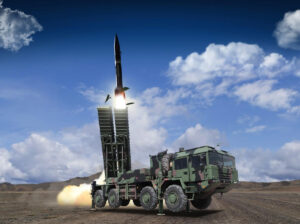The HCoC and Northeast Asian States
HCoC Issue Brief – June 2022
About the Hague Code of Conduct
Adopted in 2002, the Hague Code of Conduct against Ballistic Missile Proliferation (HCoC) is a politically binding instrument aiming to limit the proliferation of weapons of mass destruction (WMD) delivery vehicles. Composed of a set of transparency and confidence-building measures, the HCoC is the only existing multilateral instrument that focuses on WMD delivery vehicles. The HCoC has reached 143 subscribing states (December 2022) vs 93 at its inception.
When subscribing to the HCoC, states commit to abide by a set of UN treaties and international conventions on space security; to produce an annual declaration regarding ballistic missile capacities and national policy on non-proliferation and disarmament treaties and instruments; and to deliver pre-launch notifications prior to any missile or space launch. Documents are uploaded onto a dedicated online platform restricted to subscribing states and managed by Austria, which acts as the HCoC Immediate Central Contact (Executive Secretariat). Subscription to the HCoC is free of charge.
While subscribing states are asked to exercise ‘maximum restraint’ in the development of ballistic capacities, they are proscribed neither from possessing ballistic missiles nor from pursuing space launch activities. In return, subscribing to the HCoC enables states to gain access to information shared by other subscribing states, and to display their political commitment to non-proliferation and disarmament.
In brief
A majority of Northeast Asian states currently possess or seek to acquire ballistic missiles, producing a missile race and an increase in the number of tests as states are developing their capabilities further. Proliferation risks also remain high, and it is noteworthy that only South Korea and Japan have joined the MTCR.
While Japan, Mongolia and South Korea are already part of the HCoC, China could also benefit from joining, which would demonstrate that it is prepared to act responsibly in the non-proliferation realm.
TCBMs such as the Code appear especially relevant in a deteriorating security environment and rising tensions between regional states. By focusing on missiles as well as space launches, it can contribute to restoring some level of confidence and addressing ongoing space developments.
Author: Lauriane Héau
An ongoing missile race

Three out of the six Northeast Asian states1 already possess or seek to acquire ballistic missiles. Two of these states, China and the Democratic People’s Republic of Korea (DPRK), possess nuclear weapons. China tested its first atomic bomb in 1964, four years after the first DF-1 ballistic missile test. But it did not substantially develop its missile capabilities until the 1990s, following the end of the Cold War. Since then, the Chinese ballistic missile arsenal has become one of the most diversified ones, covering all ranges and mastering technological advances such as solid-fuel propulsion, MIRVed and MaRVed warheads, as well as hypersonic glide vehicles with the DF-17.2 According to U.S. sources, the country possesses around 110 Intercontinental Ballistic Missiles (ICBMs), and it has been reported in 2021 to be developing several hundred missile silos,3 which could mean a significant expansion of its strategic arsenal.
Following its withdrawal from the Non-Proliferation Treaty (NPT) in 2003, the DPRK’s nuclear and ballistic missile programmes rapidly advanced, and a first nuclear-weapon test was conducted in 2006. Today, Pyongyang possesses a range of systems, from long-range ICBMs (Hwasong-14 and 15) and Ship-Launched Ballistic Missile (SLBMs – Pukkuksong-1), to precision strike, short-range systems such as the KN-23, 24 and 25 that can target South Korea and its defences.4 The DPRK also tested a range of new systems that include a solid-fuel, hypersonic glide vehicle for the first time in 2021 and is investing on cruise missiles.5 These delivery vehicles – developed in violation of the sanctions outlined in UN Security Council Resolutions (UNSCR) – can potentially be coupled with nuclear but also chemical weapons.
Faced with a context of increasing regional instability, South Korea has acquired some new/more advanced conventional capabilities. The country is modernising and expanding its missile programme, aimed at deterring the DPRK. Following the United States’ decision to lift restrictions imposed on the South Korean missile programme, Seoul built the Hyunmoo-4, which could be used to strike underground facilities in the DPRK;6 and it carried out a successful SLBM test in 2021. The US is also an active military actor in Northeast Asia, as it offers extended deterrence to its regional allies, and has helped deploy missile defence systems in South Korea.
Moreover, other actors are acquiring or developing capabilities that are close to ballistic missiles. Taiwan has reportedly developed limited missile capabilities, including the Tien Chi, and is planning to acquire HIMARS heavy guided rockets from the US.7 Japan is currently developing a hypersonic glide vehicle, to be launched from a space launcher.8 Finally, it should be noted that missile activity is not limited to ballistic capabilities – with China, the DPRK, South Korea and Taiwan all possessing cruise missiles.
Proliferation risks
Despite the ongoing missile developments in the region, only two states in Northeast Asia, Japan and South Korea, are Missile Technology Control Regime (MTCR) Partners. Taiwan’s export control system also broadly encompasses adherence to the regime, but because of its contested political status it cannot formally participate in it. Despite a previous attempt at joining the regime, China is not part of it – but it has put in place some regulations at the national level. Yet it has a record of proliferating missile-related technology to a number of countries, including Iran, the DPRK, Pakistan, and Saudi Arabia; and it is becoming an important actor in exporting systems that fit within the MTCR guidelines.9 Last but not least, the DPRK is known to have proliferated missile technology to a wide range of actors, especially during the 1990s. Egypt, Iraq, Iran, Libya, Pakistan, Syria and Yemen all received WMD-capable systems (especially Scud or Nodong technologies) from Pyongyang, which benefited financially from these illegal transfers.10 Proliferation channels have evolved in recent years, and while proliferation cases are often harder to detect, technological transfers continue to take place.
HCoC subscription and implementation in Northeast Asia
With three states having joined, namely Japan, South Korea (both in 2002) and Mongolia (in 2006), Northeast Asia has a majority of HCoC subscribers. Those three states have also consistently voted in favour of United Nations General Assembly (UNGA) Resolutions in support of the Code. In addition, both Japan and South Korea have acted as HCoC Chairs, and Japan hosted a space launch-site visit in 2005, thereby implementing one of the voluntary transparency and confidence-building measures (TCBMs) mentioned in the text of the Code.
However, the HCoC faces difficulties with universalisation in the region. Taiwan is not able to join due to its specific status, and to this day the DPRK remains outside all non-proliferation mechanisms. China, however, may be a contender to join the Code. Beijing has previously said that it does not oppose the objectives of the Code, and it voted three times in favour of the UNGA resolutions in support of the HCoC from 2004 to 2008. China has also already agreed to limited, bilateral CBMs on missiles with Russia, through the Missile Launch Notification Agreement adopted in 2010 – and renewed in 2020. While China may be wary of the transparency measures included in the Code, as well as of its non-legally binding character, joining the HCoC could contribute to reinforcing the image of a responsible nuclear power Beijing wants to display.11

Drivers of ballistic missile proliferation in the region
Universalising the HCoC in Northeast Asia would face a number of challenges, starting with an increasingly deteriorating regional security environment. Tensions are growing between China and the United States over Taiwan, which could lead to a missile crisis if the two countries do not urgently discuss crisis management, nuclear risk reduction and TCBMs. The DPRK is also multiplying missile tests and demonstrating new capabilities. Despite the restoration of talks with South Korea in September 2021, the risk of escalation remains high.12 Moreover, ballistic missile developments in the region have global implications, that are not limited to Northeast Asia or even to the Asian continent.
The high intensity of missile testing activity in the region and in many cases the lack of transparency over such tests and developments are not conducive to improving regional stability. According to the U.S. government, China conducted over 100 ballistic missile tests in 2019 – more than any other state.13 This, coupled with a lack of transparency over China’s nuclear and ballistic missile programmes, raises questions and possible risks of misunderstandings over its intentions. In the DPRK, ballistic missile tests have also multiplied since Kim Jong Un came into power in 2012, with the latest tests showing that the DPRK has significantly improved its capabilities. This has occurred despite multiple UNSCR condemning the country’s ballistic missile tests.14

Moreover, the weakening of the global arms control architecture has implications for Northeast Asia. Aside from the DPRK, which remains outside all international non-proliferation and disarmament agreements, the level of adherence to such agreements is relatively important in the region. China, Japan, Mongolia and South Korea have all ratified the Non-Proliferation Treaty (NPT), the Biological Weapons Convention (BWC), and the Chemical Weapons Convention (CWC); they have taken steps to implement the 1540 UNSC Resolution; and have signed the three space treaties mentioned in the text of the Code. But in the current context, progress on nuclear and missile issues has been halted. The US left the Intermediate Nuclear Forces (INF) Treaty in part because it did not want to retain limitations on its Medium and Intermediate Range Ballistic Missiles while China’s arsenal was not constrained by such limitations. And neither state has ratified the Comprehensive Test-Ban Treaty (CTBT), with China’s position remaining tied to that of the US.
Space developments and the HCoC
Ongoing space developments in Northeast Asia are also relevant for the HCoC. China, Japan and South Korea especially possess a wide range of satellites for communication, earth-observation and science and technology purposes as well as for military use. With at least ten major space-launching sites in the region, space activity has significantly developed. China in particular carried out more space launches in 2021 than any other country, with 55 launches (compared to 51 for the United States).15 Japan is also at the forefront of technological advances in the space domain (except for human space flights). While space industries remain state-centered, a multiplication of private actors is observable (New Space). States such as Japan are also active in facilitating access to space for others, for instance by supporting countries such as Malaysia, Bhutan, Sri Lanka, Nepal, and the Philippines to launch CubeSats.
The HCoC is a useful tool to contribute to providing a framework for such space developments, by including the pre-notification of space launches as well as missile tests. This measure was included in the Code due to the duality of space technologies, and the similarities existing between space and missile launches. Showing transparency on ballistic missile and space capabilities can therefore be a small albeit concrete step to increase confidence. While the deteriorating security situation in Northeast Asia may not be conducive to the adoption of new instruments, existing TCBMs such as the HCoC can contribute to lowering instability.

1 In this Issue Brief, Northeast Asia is defined as comprising China, the DPRK, Japan, Mongolia, South Korea, as well as Taiwan (Republic of China), which holds a specific status as it is not recognised as a UN member state.
2 Antoine Bondaz, Daniel Liu and Emmanuelle Maitre, ‘The Hague Code of Conduct and China’, HCoC Research Paper, FRS, September 2021.
3 Matt Korda and Hans Kristensen, ‘China Is Building A Second Nuclear Missile Silo Field’, Federation of American Scientists, 26 July 2021.
4 Sangsoo Lee, ‘Missile Deployments on the Korean Peninsula: An Accelerating Arms Race’, 38 North, 7 May 2021.
5 Vann H. Van Diepen, ‘Six Takeaways From North Korea’s “Hypersonic Missile” Announcement’, 38 North, 13 October 2021.
6 Sangsoo Lee, ‘Missile Deployments on the Korean Peninsula’, op. cit.
7 ‘Taipei Economic and Cultural Representative Office in the United States (TECRO) – HIMARS, Support, and Equipment’, Defense Security Cooperation Agency, 21 October 2020, accessed on 28/10/2021: https://www.dsca.mil/press-media/major-arms-sales/taipei-economic-and-cultural-representative-office-united-states-15
8 Mike Yeo, ‘Japan unveils its hypersonic weapons plans’, Defense News, 13 March 2020, accessed on 28/02/2022 : https://www.defensenews.com/industry/techwatch/2020/03/13/japan-unveils-its-hypersonic-weapons-plans/
9 Antoine Bondaz & al., ‘The Hague Code of Conduct and China’, op. cit.
10 Emmanuelle Maitre and Lauriane Héau, ‘Current Trends in Ballistic Missile Proliferation’, HCoC Issue Brief, FRS, September 2020.
11 Antoine Bondaz & al., ‘The HCoC and China’, op. cit.
12 Elisabeth Suh, ‘Biden’s North Korea Policy – Neither Ambitious nor Adequate’, Online Commentary, DGAP, 1 October 2021.
13 ‘China fires over 100 missiles in 2019, far more than U.S.’, Kyodo News, 29 February 2020.
14 Kelsey Davenport, ‘UN Security Council Resolutions on North Korea’, Arms Control Association, April 2018.
15 Andrew Jones, ‘China plans more than 50 space launches in 2022’, Space News, 9 February 2022, accessed on 24/02/2022: https://spacenews.com/china-plans-more-than-50-space-launches-in-2022/



